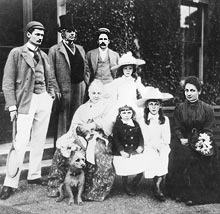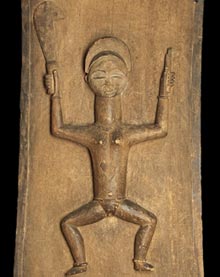Augustus Henry Lane Fox Pitt Rivers
Lieutenant-General Augustus Henry Lane Fox Pitt Rivers was born in 1827 in Yorkshire to a wealthy land-owning family. In 1841 he entered the Royal Military Academy at Sandhurst and was commissioned into the Grenadier Guards in 1845. He fought for a short time in the Crimean War, and served in Malta, England, Canada and Ireland. He finally retired in 1882, at the age of 55, with the honorary rank of Lieutenant-General although he remained on the active list until 1896. Pitt Rivers married Alice Stanley in 1853, and had nine children. In 1880 Pitt Rivers unexpectedly inherited the Rivers estate and name from his great uncle. The country estate was a substantial one and he also received an annual income of a little under £20,000: for the remainder of his life he led the life of a wealthy landowner. In 1882 Pitt Rivers was appointed the first Inspector of Ancient Monuments and in 1881-2 he was President of the Anthropological Institute. He died in 1900, at the age of 73.
Pitt Rivers' interest in collecting archaeological and ethnographic objects came out of his early professional interests in the history of firearms. It is generally believed that Pitt Rivers did little field collecting but, in fact, he did obtain a few objects whilst on active service, during a tour of Europe, in Malta and during the Crimean War. Although he collected some artefacts whilst 'in the field', the vast majority of objects in his collection came from dealers, auction houses, and from fellow members of the Anthropological Institute (such as E.H. Man, John Petherick, Richard Burton and E. Belcher). It is difficult to estimate the overall size of Pitt River's collection. Some 20,000 objects were donated to the Pitt Rivers Museum in 1884, but there was also a sizeable collection of objects displayed at his personal museum in Farnham, Dorset after this date.
Pitt Rivers always believed in the collection of everyday objects as well as 'work of art' and this is reflected in his collection. Pitt Rivers described the intellectual framework for his collection and museum displays as:
The objects are arranged in sequence with a view to show ... the successive ideas by which the minds of men in a primitive condition of culture have progressed in the development of their arts from the simple to the complex, and from the homogeneous to the heterogeneous. ... Human ideas as represented by the various products of human industry, are capable of classification into genera, species and varieties in the same manner as the products of the vegetable animal kingdoms ... If, therefore we can obtain a sufficient number of objects to represent the succession of ideas, it will be found that they are capable of being arranged in museums upon a similar plan. [Pitt Rivers,1874:xi and xii]

Pitt Rivers and family(w. Fox Pitt, General Pitt-Rivers, Hon. Mrs Pitt-Rivers, Douglas Fox Pitt, Mrs W.C. Scott And Children).
(Detail of 1998.271.5 .1-.3, copyright PRM)
Needless to say, attitudes to the objects and the intellectual basis upon which they are studied have changed since Pitt Rivers' collections were given to the University. Today the museum is still organised typologically but does not (and could not) show the supposed evolution of objects from the simple to the most complex.
Archaeology became very important to Pitt Rivers; he purchased archaeological items from dealers and sale rooms, but also carried out excavations of his own, principally in Ireland during his service there in the 1860s, and in England (London, Yorkshire, Sussex and his own estates in Dorset). He documented his archaeological work fully, causing detailed site plans to be prepared and wooden models to be made.
Pitt Rivers very soon exhausted the space available in his own house to show his collections. In 1873, he decided that his collection should be publicly exhibited and arranged with the South Kensington Museum to display around 10,000 objects at the Bethnal Green branch of that Museum. In 1878 his collection was moved to the South Kensington Museum. In 1880 he decided his collection should have a permanent home and eventually settled upon the University of Oxford. On 30 May 1882 the University accepted the offer of Pitt Rivers' collection; a three storey annexe, measuring approximately seventy by eighty-six feet, was built onto the eastern side of the University Museum (of Natural History) to house the collection. Henry Nottidge Moseley, Head of the Department of Zoology and Comparative Anatomy, was put in charge of the collection and Edward Burnett Tylor was appointed the first Lecturer in Anthropology in Britain. The University undertook to carry on Pitt Rivers' general method of arrangement of objects during his lifetime and agreed that "any changes in details ... shall be such only as are necessitated by the advance of knowledge". Although Pitt Rivers' original stipulations had suggested an on-going concern with his collection once it was given to Oxford, he did not display much interest in it, transferring that to his new museum in Farnham, Dorset.
Further Reading

Door with carved female figure. Possibly collected by Robert Bruce Napoleon Walker. Obtained in December 1875 and donated by Pitt Rivers to this Museum in 1884
(Detail of 1884.56.47, copyright PRM)
Blackwood, Beatrice. 1970. The classification of artefacts in the Pitt Rivers Museum Oxford. Occasional Papers on Technology no 11 Pitt Rivers Museum, Oxford
Bowden, Mark 1984 [reprinted 1990] General Pitt Rivers" the father of scientific archaeology Salisbury and South Wiltshire Museum
... 1991. Pitt Rivers - The life and archaeological work of Lt. General Augustus Henry Lane Fox Pitt Rivers DCL FRS FSA . Cambridge University Press, Cambridge, UK.
Bradley, Richard 1983 'Archaeology, evolution and the public good: the intellectual development of General Pitt Rivers Archaeological Journal 140: 1-9
Chapman, William R. 1984. 'Pitt Rivers and his collection, 1874 - 1883: The chronicle of a gift horse' in Cranstone and Seidenberg 1984
.... 1985. 'Arranging Ethnology' in Objects and Others, History of Anthropology Series ed G. Stocking, University of Wisconsin Press
.... 1989. The organisational context in the history of archaeology - Pitt Rivers and other British archaeologists in the 1860s Antiquaries Journal 69 23-42
.... 1991. Like a Game of Dominoes: Augustus Pitt Rivers and the Typological Museum Idea' in S. Pearce Museum Economics and the Community vol 2 New Research in Museum Studies Athlone London
Cranstone, B.A.L. and S. Seidenberg. 1984. The General's Gift - A celebration of the Pitt Rivers Museum Centenary 1884-1984 . JASO Occasional Paper, Oxford, UK
Gray, H. St. G. 1905. 'A Memoir of Lt-General Pitt-Rivers' [sic] in Excavations in Cranborne Chase vol V. Somerset [privately published]
Oxford University Anthropological Society. 1953. Anthropology at Oxford: The Proceedings of the Five-hundredth meeting of the Oxford University Anthropological Society Oxford
Petch, Alison 1996. 'Weapons and the 'Museum of Museums' Journal of Museum Ethnography , vol. 8 May 1996: 11 - 22
.... 1996. [editor] Collectors and Collecting Pitt Rivers Museum, Oxford
.... 1997. The early history of Lieutenant-General Pitt Rivers's collection and the Pitt Rivers Museum in Oxford [PRM booklet]
.... 1998. [editor] Collectors and Collecting Volume 2 Pitt Rivers Museum, Oxford
.... 1998. 'Cataloguing the Pitt Rivers Museum founding collection'. Journal of Museum Ethnography
.... 1998. ''Man as he was and Man as he is': General Pitt Rivers' collections' Journal of the History of Collections 10 no. 1 (1998) pp 75 - 85 Oxford University Press
.... 1999 Cataloguing the Pitt Rivers Museum founding collection. Journal of Museum Ethnography 11 1999 pp 95 - 104
.... 2000 Coote, Jeremy; Chantal Knowles, Nicolette Meister, and Alison Petch 'Computerizing the Forster ('Cook'), Arawe, and Founding Collections at the Pitt Rivers Museum', Pacific Arts , nos. 19/20 (July), pp. 48-80.
.... 2002. ' Assembling and Arranging: Pitt Rivers' collections from 1850 to now' in 'Collectors: Expressions of Self and Othe r Occasional Papers Series: Horniman Museum and Museu Antropologico of the University of Coimbra
.... 2003 'Documentation in the Pitt Rivers Museum' Journal of Museum Ethnography , No. 15 pp 109-114
Pitt Rivers, Augustus Henry Lane Fox. 'Primitive Warfare. Parts I - III'. JRUSI 11 [1867] 612-43 and JRUSI 12 [1868] 399-439 and JRUSI 13 [1868] 509-39 [repeated in 'The Evolution of Culture']
.... 'On the principles of classification adopted in the arrangement of his anthropological collection now exhibited in the Bethnal Green Museum.' JAI 4 [1874] 293-308
.... 1874. Catalogue of the Anthropological Collection lent by Colonel Lane Fox for exhibition in the Bethnal Green branch of the South Kensington Museum June 1874 Parts I and II . London, Science and Art Department of the Committee of Council on Education HMSO [Re-issued 1879]
.... 1906 [ed. J.L. Myers, introduction by Henry Balfour] The Evolution of Culture and other essays Clarendon Press Oxford UK
Thompson, M.W. 1976 Catalogue of the correspondence and papers of Augustus Henry Lane Fox Pitt -Rivers (1827 - 1900) Royal Commission on Historical MSS List 76/75
... 1977. General Pitt Rivers: Evolution and Archaeology in the Nineteenth Century. Moonraker Press, Bradford-on-Avon UK
Thompson, M. and C. Renfrew. 1999. 'The catalogues of the Pitt-Rivers Museum, Farnham, Dorset' Antiquity 73 pp 377 - 392
Tylor, E.B. Dictionary of National Biography entry for Pitt Rivers
Alison Petch
August 2005


